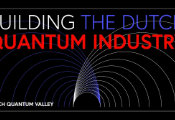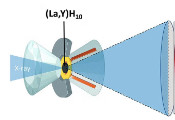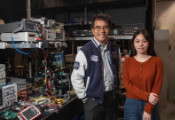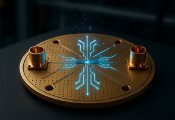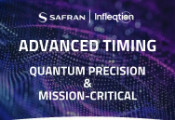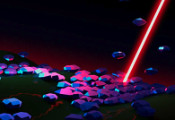NTU Singapore-Led Discovery Poised to Help Detect Dark Matter and Pave the Way to Unravel the Universe’s Secrets
January 09, 2025 -- Researchers led by Nanyang Technological University, Singapore (NTU Singapore) have developed a breakthrough technique that could lay the foundations for detecting the universe’s “dark matter” and bring scientists closer than before to uncovering the secrets of the cosmos.
The things we can see on Earth and in space – visible matter like rocks and stars – make up only a small portion of the universe, as scientists believe that 85 per cent of matter in the cosmos comprises invisible dark matter. This mysterious substance is said to be the invisible glue holding galaxies together. Finding it could help us understand cosmic phenomena that cannot be explained solely by the matter we see.
But proving the existence of dark matter is a herculean task. As its name suggests, dark matter is “dark”, meaning it does not normally emit or reflect light, carries no electric charge and interacts extremely weakly with normal matter, making it undetectable with conventional scientific instruments.
Dark matter is likely made up of particles and among the hypothetical particles proposed for it, a leading candidate is the axion.
Scientists have spent four decades looking for axions. One approach seeks to prove through experiments that existing particles in nature, like electrons or light particles, can behave like theoretical axions. If scientists can observe such behaviour, it increases the likelihood that axions might be real. The findings can then serve as a springboard to develop a method for detecting actual axions.
Despite coming close, the results from the search for axions remain inconclusive. But scientists led by NTU Singapore have now confirmed that naturally existing particles can indeed act like axions.
The researchers’ experiments showed that when light particles, also called photons, travel inside special crystal structures that they designed, the photons move like theoretical axions.
“The findings from our new crystal structures give us more confidence that we could one day use the crystals to detect real axions,” said Professor Zhang Baile from NTU’s School of Physical and Mathematical Sciences (SPMS), who led the researchers. “And since axions are promising candidates for dark matter, our research might lay the groundwork for unravelling some of the universe’s greatest mysteries.”
The study was reported in the scientific journal Science today (10 January 2025).
Illuminating the darkness
The term dark matter, coined in the 1930s, refers to the invisible glue hypothesised to prevent spinning galaxies from breaking apart, as there is not enough visible matter to account for the gravitational forces holding them together. So, dark matter could be the backbone undergirding the universe, which explains how galaxies form and evolve.
The axion is the current leading theoretical particle postulated to form dark matter. Its history can be traced to physicists Roberto Peccei and Helen Quinn, who, in 1977, proposed a concept to solve a particle-physics puzzle. Later, in 1978, physicists Frank Wilczek and Steven Weinberg independently realised the concept suggested that a new particle existed. Wilczek dubbed this particle the axion, after a laundry detergent brand, as it “cleaned up” a theoretical mess in physics.
Axions are believed to have originated from the sudden expansion of the universe after it was created in a cosmic event called the Big Bang. If axions are the main components of dark matter, they would be very hard to detect.
Even so, theory predicts that real axions can convert into photons in a powerful 10 Tesla magnetic field, which is 10 times stronger than the industrial electromagnet used to lift cars in scrapyards.
When axions convert into photons, the light particles can be detected using traditional equipment to show that axions exist. However, the conversion is expected to be highly inefficient, so the signals from converted photons would be weak and easily masked by other signals. So far, attempts to measure the signals of converted photons have not succeeded.
Scientists have also been trying another approach to finding axions: showing that naturally existing particles like electrons and photons can mimic axion behaviour and then use the information to develop a method to detect actual axions.
Researchers have traditionally focused on trying to prove that electrons can act like axions. But past studies have only shown electrons moving like axions in two dimensions – such as travelling horizontally and vertically – which is not good enough since axions move and exist in three dimensions.
NTU’s Prof Zhang led his team to address this issue by turning to photons. Earlier, his team worked on layered crystal structures with magnetic properties that can change how light particles travel and behave in them. The scientists had tried to use these crystals to simulate exotic particles that are hard to find in nature. But in the process, the scientists realised that they might have found traces of the elusive axions.
Looking also at past theoretical work that links axions to magnetic fields oriented in opposite directions, the researchers hypothesised that photons within the crystal could exhibit axion-like behaviour if a crystal’s layers had alternating magnetic properties.
The hypothesis was confirmed through experiments conducted by Prof Zhang’s team in collaboration with Prof Chong Yidong, also from SPMS, and other scientists.
In their study, the researchers used carefully designed crystalline geometric structures made of an artificial garnet crystal called yttrium iron garnet. This material has unique magnetic and optical properties and is used in microwave devices within radar and telecommunication systems.
In their experiments, the team observed that photons travelled in a single direction on the three-dimensional edges of the crystal’s structure – such as moving horizontally, vertically and sideways – without issues like scattering backwards. This behaviour of the photons in the crystal is also what theory predicts for axions.
To find real axions in the future, scientists could attempt to optimise the crystal designs further and use them in experiments to detect photons converted from axions under extreme conditions, such as strong magnetic fields. However, achieving this would require significant effort and resources. The team believes that their crystal structures might be able to boost the weak signals of axion-converted photons, but more research is needed to confirm this.
Professor Yannis Semertzidis, from the Korea Advanced Institute of Science and Technology in South Korea and who was not involved in the NTU-led study, said that axions are an ideal, leading candidate for dark matter and likely contribute to a significant portion of it.
Prof Semertzidis, who researches on axions, said that the NTU-led study is a major breakthrough, and that the crystal structures used in the study set the stage for a “promising alternative” to existing methods for finding axions. He noted that the crystal structures have internal magnetic fields that “are perfectly suited for axion detection”.
“These crystal structures are expected to become a practical tool for searching axion dark matter in the near future,” added Prof Semertzidis.

